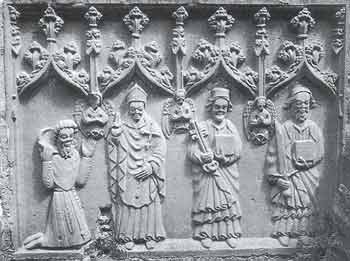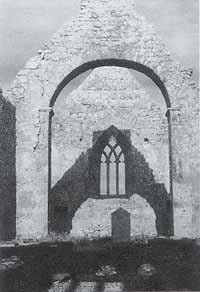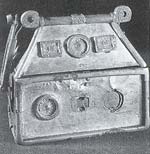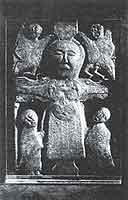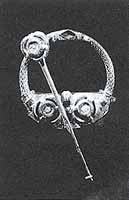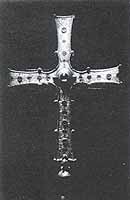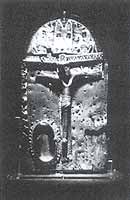The Early British Church
Rev. Fr. Gerard Culkin
Celtic mysticism exerts a fascination on many today, and now has devotees to be found among many types of Christian denominations, or even among non-Christians. This thinking is found in one of the standard propaganda texts, Wisdom of the Celtic Saints (Edward C. Sellner, Ave Maria Press, Notre Dame, Indiana, 1993), and shows why it is necessary in this article to prove that there is no basis in fact for such an anti-Catholic fancy:
...[Tensions in Christianity] ultimately resulted in the submersion of the Celtic church in Ireland by the Roman ecclesial system in the twelfth century.
Still, despite that "reform," which was a triumph for ecclesial administrators but a tragedy for Irish culture and creativity, Celtic Christian spirituality survived in various geographical locations where the saints had once lived or journeyed. It deeply affected directly or indirectly certain religious traditions and wisdom figures, including Hildegard of Bingen, Francis of Assisi, Julian of Norwich, Joan of Arc, George Herbert, Evelyn Underhill, and Thomas Merton. In many ways this Celtic spirituality is the foundation of Anglican, Episcopalian, and Methodist spirituality, and, because of its love of the desert fathers and mothers, it has a great affinity with the spirituality of the Eastern Orthodox. With its focus upon nature and the entire spiritual realm, and its respect for ancestors, visions, and dreams, it finds resonance with Native American spirituality too. Thus, the spirituality of the Christian Celts has great ecumenical value, for it transcends the differences which have divided Christians in the East and the West since before the Reformation. It also has special appeal for many of us today who are concerned about the ecological survival of our planet, the revitalization of our churches, and the quality of our own spiritual life....
Straid Abbey Sculpture Found in County Mayo's principal town, Castlebar, near the village of Knock, site of the Blessed Virgin's apparition in 1879
Throughout his book, this author speaks with the urge of many who look on these heroic Celtic monks not only as forming an independent Church as regards their allegiance to the Pope, but also as possessing a mysticism opposed to that of the big bad "Roman Church." In fact, it would be truer to say that the "Roman Church" is often presented as having no mysticism at all and being its sworn enemy. The spiritual, mystical Celts are contrasted sharply with the bureaucratic and dogmatic Roman Catholics. As a result it would be quite possible for such minded people to accept with this dissertation, that the Celtic Church was bound by links to Rome, and yet still believe that in spirit the two "Churches" were entirely separate. In that case the union with Rome would have been looked upon by the Celts as something of completely secondary importance, a matter of "red tape," to which little thought had been given and little significance attached. By this chain of reasoning, the way would seem to be paved for a return to this spirituality and mysticism, without any need to adopt the beliefs and practices of Roman Catholics, and such indeed is what many at the present moment believe. And yet, the Celtic spirituality is inseparably bound up with the spirit and teachings of the Roman Catholic Church. The Church's doctrines too formed the foundation and inspiration of all their mysticism.
The purpose of this foreword is to ever so briefly state and explain what was the real state of affairs in a Celtic monastery.
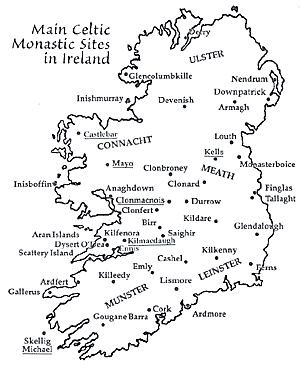 The roots of this current matter are found in the syncretism so much in vogue today, and so much de rigueur. Taken in general, this teaches that all religions lead to the same end, and all are but partial aspects of the one real religion. For such people the "real religion" is mysticism. This mysticism is the end to which all religions tend and lead, and is the perfection and fulfillment of them all. All these religions, characterized by conflicting beliefs, are for them then only the immature beginnings of the true religion, which is common—they say—to all mystics, whatever their "base" religion might be. So for example, Hindu, Buddhist, Islamic, and Christian mysticism, etc. are fundamentally the same thing for them, and this is based on the admittedly surprising similarities to be found in all forms of mysticism. In reality, the similarities between Christian and other mysticisms are only skin deep, but that is something we will come back to. Although it might look callous to pour cold water on so much enthusiasm, it must be plainly said, that this outlook was completely alien to those Celtic monks and all they stood for. Consequently, to adopt their ascetical and mystical practices and outlooks within such a syncretistic framework, is to condemn oneself to living an unreality, not to mention being guilty of an enormous anachronism. The following paragraph gives a short summary of the reasons why.
The roots of this current matter are found in the syncretism so much in vogue today, and so much de rigueur. Taken in general, this teaches that all religions lead to the same end, and all are but partial aspects of the one real religion. For such people the "real religion" is mysticism. This mysticism is the end to which all religions tend and lead, and is the perfection and fulfillment of them all. All these religions, characterized by conflicting beliefs, are for them then only the immature beginnings of the true religion, which is common—they say—to all mystics, whatever their "base" religion might be. So for example, Hindu, Buddhist, Islamic, and Christian mysticism, etc. are fundamentally the same thing for them, and this is based on the admittedly surprising similarities to be found in all forms of mysticism. In reality, the similarities between Christian and other mysticisms are only skin deep, but that is something we will come back to. Although it might look callous to pour cold water on so much enthusiasm, it must be plainly said, that this outlook was completely alien to those Celtic monks and all they stood for. Consequently, to adopt their ascetical and mystical practices and outlooks within such a syncretistic framework, is to condemn oneself to living an unreality, not to mention being guilty of an enormous anachronism. The following paragraph gives a short summary of the reasons why.
The union of the Celtic church with the universal Church at this time can only mean that they both had in common the same outlook in matters of faith. But that outlook of the Catholic Church, throughout the rest of the world at that time, is amply documented. For example, fundamental to their religious outlook was the firmly held belief that to be saved from an eternity of torments it was first of all necessary to believe all that she, the Church, proposed for belief. Typical of this attitude is the Athanasian Creed, which dates from the fourth century. It opens thus: "Whoever wishes to be saved, needs above all to hold the Catholic Faith; unless each one preserves this whole and inviolate, he will without doubt perish in eternity." There then follows an extremely long and detailed statement, concerning the Trinity and Incarnation, which is rounded off by the threat of hell. The closing words are: "This is the Catholic Faith; unless every one believes this faithfully and firmly, he cannot be saved."
Every provincial and general council of the time shares this attitude, and expresses it too in no uncertain terms. Everywhere anathemas are fulminated against all who refuse to believe. Dogmatic faith, i.e. the necessity for salvation, of believing certain defined truths, held the primacy. If somebody refused belief, be it in only one point, he was a heretic condemned to perdition, and no amount of ascetical or mystical savoir-faire could compensate. This is seen clearly in the monks of the East, who when some fell into Nestorianism or Monophysitism were, notwithstanding their heroic lifestyle, forthwith regarded as heretics pure and simple. The whole question of the necessity for salvation of belonging to the Catholic Church, was to receive fresh emphasis and clarity from St. Augustine, a result of his disputes with the Donatists, which of itself suggests most strongly their agreement with Rome in this important matter. Moreover, it is impossible to imagine how a portion of this Universal Church, to which the Celtic church assuredly belonged, could be opposed to this "fundamentalist" attitude without staging an open protest of some kind, but of this we have not the slightest indication. It is undoubtedly against all rules of historical criticism to build up a whole theory based on the "argument from silence." In any case there is actually overwhelming positive evidence, that they thought and felt, in all essentials, like their contemporaries in the Catholic Church. For example, St. Patrick and St. Ninian (see below,"Celtic Saints Prove Communion with Rome") were both educated in monastic life on the continent. The latter was even ordained bishop in Rome and sent by the Pope to preach the Gospel in Scotland. Let St. Columba have the final word here:
Let the cause of schism be immediately cut off with the sword of St. Peter, that is, by a true confession of faith in a synod, and the detestation and anathematisation of all heretics....The Roman Church admits none to its communion who impugn the Catholic Faith.
A major consequence of the above is its impact on the mystical communing of the Celts with God. It is best seen in contrast to the "mysticism" so much vaunted today. In this, the chief hallmark is its contempt of what they would call merely rational, "scientific" thinking. This contempt is carried to the point, that they believe that, for mysticism to be really worthy of the name, it ought to be in contradiction with reason and this for example, is the cornerstone of the whole New Age Movement. Mysticism and reason are two entirely separate categories. No connection exists between them, so that the great religion of mysticism can be in no way supported by "proofs" and is proud to stand in flagrant contradiction to the truth—"truth" being for them after all "only" a product of reason. In short, anything goes! Believe what you like, live as you like, should be the logical conclusion of all this, but luckily for many, logic is as difficult as it is distasteful.
For many Celtic monks however, committed to a dogmatic faith, and thus holding certain facts to be absolutely and infallibly true, mysticism must take on a different coloring. For in this case, mysticism could never contradict the Faith, which here took absolute priority. Or, if it were to do so, it would be a false mysticism, and the mystic would be a heretic. In any conflicts of the two, the cardinal principle must be that the faith is correct and the mystical intuition false. Instead of mysticism lording it over reason, or now, in this case, faith, it instead was to be judged, corrected and controlled by the Faith. The whole outlook is summed up in the words of St. Thomas Aquinas: "Although Faith transcends reason it never contradicts it." Yes, for these Celtic monks, even though they knew well that, in comparison with the direct or experimental knowledge of divine things, the dogmas were but as straw, they believed nevertheless that they still expressed a real truth. A mystical knowledge of these things would deepen and intensify the faith but never mean their negation. In fact, it was the consideration of the dogmas of the Catholic Faith that formed the subjects of their meditations. Moreover, as is abundantly clear from the writings of the Church Fathers, (who lived in the days of the Celtic church), it was in believing and putting into practice these dogmas, that religion essentially consisted, not merely in the acquiring of esoteric or hidden knowledge. Any mystical intuitions were subservient to this ultimate purpose and were not given for their own sake. Only in heaven, in the full vision of God would the obscurity of faith be replaced by sight.
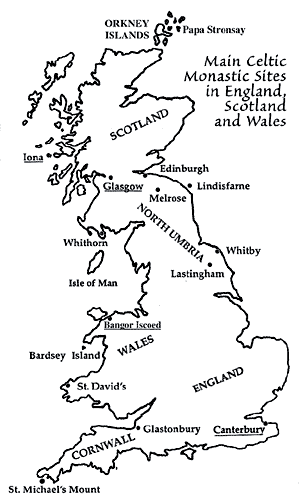 It is, then, a fatal mistake to judge of Celtic monasticism outside of its historical context, leading as it does to such misleading ideas. If someone knowing little of the history of the Catholic Church were one day to come across, say, the "Little Flowers of St. Francis," flicking through this he could well believe that this movement and its founder had no connection with the "Church of Rome," making so little mention as it does of dogmas and other specifically "Romish" things. Yet what could be more false! When something is so well known and believed there is no need to be continually bringing it up on every page. Instead, it is taken for granted, and used as a launching pad for further considerations and developments. Actually, the Franciscan spirituality has a great deal in common with that of the Celtic monks; for example, its emphasis on bodily penance, poverty, joy in nature, cheerfulness, and its poetic tendencies. It shows how such mysticism can be quite easily imbedded and incorporated within the framework of the Catholic Church.
It is, then, a fatal mistake to judge of Celtic monasticism outside of its historical context, leading as it does to such misleading ideas. If someone knowing little of the history of the Catholic Church were one day to come across, say, the "Little Flowers of St. Francis," flicking through this he could well believe that this movement and its founder had no connection with the "Church of Rome," making so little mention as it does of dogmas and other specifically "Romish" things. Yet what could be more false! When something is so well known and believed there is no need to be continually bringing it up on every page. Instead, it is taken for granted, and used as a launching pad for further considerations and developments. Actually, the Franciscan spirituality has a great deal in common with that of the Celtic monks; for example, its emphasis on bodily penance, poverty, joy in nature, cheerfulness, and its poetic tendencies. It shows how such mysticism can be quite easily imbedded and incorporated within the framework of the Catholic Church.
In conclusion, may people by all means let themselves be inspired by the soaring mysticism of the Celtic monks, but let them remember too the beautiful doctrines of the Catholic Church which these monks themselves would have undoubtedly striven firstly to impress on their minds and from which their mysticism took its rise.
The claim is sometimes made by the Anglicans that this ancient British Church was the ancestor of the present Church of England, and accordingly they maintain that they are the true Catholic Church in this country. This claim is quite unfounded. The early British Church was not a national and independent body like the modern Church of England, but was simply that part of the one Catholic Church which was established in Britain. The first British Christians professed the same faith as the rest of the Catholic Church. With Christians everywhere they acknowledged the Pope, the Bishop of Rome, as Head of the Church in succession to St. Peter. That this was so is proved clearly enough by the history of the relations between the Church in Britain and the Roman See in these early days, and by such evidence as we have about the faith and practice of these first British Christians.
THE EARLY CHURCH AND THE SEE OF ROME
We know very little about the origins of the Church in Britain. There are many legends about its early history, but no reliable evidence about its first foundation. The first Christians in Britain were probably to be found among the soldiers of Rome who garrisoned the country after it was conquered by the Romans in the first century of our era, or among the traders from the lands about the Mediterranean who came here at that time. We first hear of the Church in Britain from Tertullian, an African who wrote at the end of the second century, but he tells us no more than the bare fact that there were Christians in Britain in his time. There is a reliable tradition that some British Christians were put to death for their faith about 100 years later. The best known among them is St. Alban, but we know little about him beyond the simple fact that he died as a martyr. The British Church first appears in the records of history in the year 314, when three bishops from this country were present at a council held at Arles in the south of France. During the rest of this century bishops from Britain were present at other ecclesiastical councils, showing that the British church was in no way isolated, but was in active communion with the rest of the Church in the Empire. In the first part of the fifth century there is evidence which seems to indicate that the church in Britain was rapidly expanding. Then came disaster. The city of Rome itself was threatened by barbarian attacks from the East. The Roman garrison was withdrawn from Britain. The country was defenseless, and soon it was in its turn invaded and conquered by the Anglo-Saxons, the ancestors of the English people. The British Christians were driven from their homes and sought refuge in the hills and waste places of the west, in Wales and Stratclyde and Cornwall. In the rest of the country, as far as we can discover, the Church simply ceased to exist. Not until the Roman monk Augustine landed in Kent nearly 150 years later, in 597, did the conversion of the pagan Anglo-Saxons begin. For all this time the conquered British were cut off from the rest of the Christian world, and this enforced isolation was to have at least one unfortunate consequence. But this temporary separation from the rest of the Catholic Church was not of their seeking.
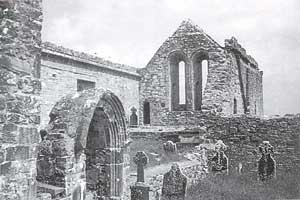 |
Killone Abbey A 12th-century National Monument, one of Ireland's few convents. Located in Ennis in County Clare an the River Suir in the west of Ireland.
|
One of the results of this disaster was that most of the records of the early Church in Britain perished, and in consequence we know very little indeed about its history. But there is enough evidence to show beyond all doubt that for more than 100 years the British Christians were in active communion with the rest of the Catholic Church in the Roman Empire.
We have already seen that there were three bishops from Britain present at the Council of Arles in the year 314. At this council, which was summoned by the Emperor Constantine to deal with the heresy of the African Donatists, there were present bishops from all parts of the Western Empire. It is significant that, from its first appearance in historical records, the British Church appears not as an isolated unit, nor as a national or independent church, but as actively co-operating with other parts of the Church in defense of the common Catholic Faith. The bishops at Arles clearly recognized that the decisions they made there would have to be approved by the Pope if they were to be accepted by the rest of the Catholic world. We know little enough of what went on in the council, but when it was over the bishops wrote to Pope Sylvester, whose legates had been present at their meetings, to tell him that they had acted "as though you yourself were present," and asking him, "according to custom," to send letters to all the churches to inform them of the decisions taken at Arles. Thus, as a recent Anglican historian has remarked, the bishops of the council, and the British among them, clearly acknowledged the right of the Pope "to give a decisive opinion on disputed questions of doctrine and discipline."1
For the next 150 years the Christian faith was under constant attack from heretics. It was to defend the Faith against these attacks that the first great ecclesiastical councils were held at this time. Ten years after Arles came the first of the ecumenical councils, held at Nicea, to deal with the heretic Arius, who denied that Christ was the Son of God. It is not certain that British bishops were present at Nicea, but the decrees of the council were received by the Church in Britain. And the British Church was represented at the later councils of Sardica, in 343, and Rimini in 359. This great movement in defense of orthodoxy was, at least in its later stages, largely directed and controlled by the Roman See, acting as Head of the Church and clearly recognized as such throughout the Catholic world. As a result, bishops from both East and West turned increasingly to Rome at this time for decisions on disputed points of doctrine and discipline, and readily accepted the judgments of that See. In the year 404, Victricius [Bishop of Rouen] was himself a Briton. It is quite certain that some years earlier he had been asked by the bishops of Britain to settle some serious differences which had arisen there. It seems evident that he was regarded by the British bishops as a pattern of orthodoxy, and it seems clear that they shared his faith in this matter of the Pope's supreme authority as in everything else.2
| Clonmacnoise Cross Outside the cathedral site of Ireland's greatest monastery, Clonmacnoise, is one of the finest crosses in Ireland, the Cross of the Scriptures (10th century). Each of its four sides is a pictorial catechism of the Scriptures. On the west face (seen above) are the Watching of the Tomb, the Arrest, the Betrayal and, above, the Crucifixion. On the base of the cross can be seen a hunting scene with horsemen, chariots and various animals. |
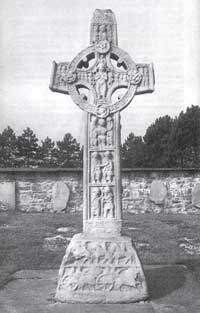 |
ST. GERMANUS AND THE PELAGIANS
That the Church in Britain did wholeheartedly accept the authority of the Bishop of Rome at this time is conclusively proved by two other incidents which occurred some years later. In the year 421, the teachings of the heretic Pelagius, who was either a Briton or an Irishman, were condemned at Rome. Within a year or so, some of his followers appeared in Britain and began to spread his doctrines there. "Characteristically," say the authors of the standard work on the history of Roman Britain, "the Britons appealed to the Pope for help against this invasion."3 The Pope, Celestine I, sent to Britain as his own representative, Germanus, the Bishop of Auxerre. Germanus was successful in his mission, and brought back to the Catholic Faith many who had been led astray by the teaching of the Pelagians. This first mission lasted from 429 to 431. Some years later the heresy revived, and Germanus was invited to Britain a second time, in 446-7, bringing with him Severus, who was probably the Bishop of Treves. The incident is evidence both of the close relations between Britain and Rome and of the complete unity of faith between the churches in Britain and Gaul. The memory of Germanus was long honored among the British Christians, both St. Patrick, the apostle of Ireland, and St. Illtyd, the first great figure in the British Church in Wales, were taught by Germanus at Auxerre. The great authority of Germanus in this country was certainly due in large part to the fact that he was sent here by the Pope himself, and the honor done to his memory reflects the loyalty of the Church in Britain to the See of Peter.4
Some years later, in the time of Pope St. Leo the Great, 440-461, a new ruling was sent out from Rome about the date on which the Easter festival was to be celebrated. By this time the Roman Empire was already disorganized by the barbarian invasions, communications were difficult, and it was some considerable time before the news of the Pope's decision reached Britain. But as soon as it was known there, it was at once obeyed.5
This is the last we hear of relations between the Church in Britain and the Roman See for a century and a half. As a result of the invasions and the collapse of the Empire, all contact with the Church abroad ceased until the coming of St. Augustine in the year 597. These few facts, then, are all that we know of the relations between the first British Christians and the papacy from the first establishment of the Church in this country until nearly the end of the sixth century. The evidence is scanty indeed, but it is clear enough and can admit of only one conclusion. Far from being a separate unit with a distinctive doctrine or discipline, the Church in Britain throughout this time appears as simply a part of the one Catholic Church. Its bishops unite with the bishops of other lands in defense of their common Catholic Faith. If they are in difficulties, the bishops in Britain appeal to their brethren abroad for advice and help. In cases of special difficulty they turn, as other bishops turn, to Rome. If the Pope issues an instruction or a command, it is obeyed in Britain as it is obeyed elsewhere, because the British Church recognizes the Pope as the head of the Universal Church. Nowhere in the history of the Church in Britain at this time is there even a shred of evidence that British Christians resented this exercise of papal authority as an intrusion, or ever claimed the right to settle their own affairs in their own way.
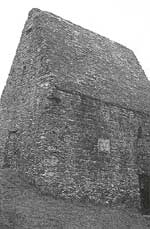 |
House of St. Columba This is one of the residences of the greatest Irish missionary of the sixth century, Columba, the "dove of the Church." It is located in Kells, County Meath, where St. Columba established a monastic settlement. Columba was later excommunicated by an Irish synod of the Catholic Church, accused of starting a civil war. The excommunication was lifted but the sin remained to be expiated. Columba's penance was to be permanently exiled on mission for Christ. On May 12, 563, he landed on the island of Iona. There he built a monastery. From that monastery, beginning with a mission to the king of the barbaric pagan Picts in Druid-haunted Inverness, he undertook the conversion of Britain, which except for Wales was now almost entirely pagan.
|
THE CELTIC CHURCHES AND ROME
All that has been said of the relations between the British Church and the Roman See at this time is equally true of the other early Christian communities in these islands, the so-called Celtic Churches.
The Faith was first preached in what is now Scotland by St. Ninian, early in the fifth century. We know little about him. He was probably a Briton, but it was at Rome that he was instructed in the Faith before setting out on his mission, and as a recent non-Catholic author had indicated, there is no doubt that he was a "Roman" Catholic.6
In the year 431, Pope Celestine I consecrated a certain Palladius and sent him to Ireland as the first bishop of that country. He was soon followed by St. Patrick, who was a Briton, and who, after completing the conversion of the greater part of the country, instructed his priests that if any difficulty should arise which they could not settle among themselves, they were to refer the matter to "the Apostolic See" in Rome.7 The Irish monks, some of whom settled at Iona off the west coast of Scotland in the course of the sixth century, and from there sent out missionaries to northern England, and others, led by the great St. Columba, who preached the gospel in Gaul, were equally clear about the authority of the Roman See. St. Columba called the Pope "the pastor of pastors," and "the head of the churches in Europe," and called on him as the guardian of the Faith to condemn the practices of some of the clergy in Gaul, whom he regarded as schismatics.8 Since they were founded at a time when, owing to the invasions, communication with the rest of the Church was always difficult and sometimes impossible, all these Celtic churches tended to develop certain customs which differed from Roman practice. For example, the Celtic monks wore a different tonsure, there were some variations in their manner of administering baptism and in the date on which the Easter festival was observed. But all these differences were in secondary matters. None of these communities held any distinctive doctrine, or made any claim to be an independent church. We may apply to each of these Christian communities what a leading authority has said of the British Church during the years of its isolation: that, in spite of this isolation, "it never ceased to be Catholic in doctrine and to acknowledge the spiritual supremacy of the successors of St. Peter."9 For the Celts and the British, as for Christians everywhere, to have attempted to repudiate the authority of the See of Rome would have been to cut themselves off from the unity of the one Catholic Church.
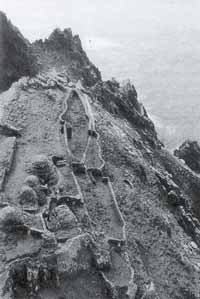 |
Monastic Settlement (Skellig Michael) From the lighthouse on the island which stands 164 feet above sea level, there are 670 steps hewn from the rock a thousand years ago leading up to the saddle between the island's two rocky peaks. Visitors turn right to reach the narrow man-made terraces with the well-preserved remains (National Monument) of the monastic settlement founded by St. Finan in the 9th century—six beehive huts with a circular exterior and a rectangular interior; two boat-shaped stone oratories; lower down, remains of a church, probably of the 12th century; small gardens, a well, gravestones and remains of a sundial; and finally enclosure walls on the edge of a dizzying precipice. After the monks left the island in the 13th century many pilgrims continued to come, climbing to the highest point to kiss the ancient stone standing upright in the rock. Because of the dizzying height, it is strictly forbidden to spend the night on the island. |
ST. AUGUSTINE AND THE BRITISH CHURCH
The argument of those Protestant apologists who claim that this early British Church was in some way a national Church like the modern Church of England owing no allegiance to Rome and rejecting the papal claims, rests on a single incident only. A year or two after the beginning of his mission to England in 597, St. Augustine, following the instructions of Pope Gregory, had two meetings with the British bishops. He appealed to them to co-operate with him in the work of converting the Anglo-Saxons. After some hesitation and on the occasion of the second meeting, they refused, and this refusal has been taken as an indication that they regarded the Pope as having no authority over them. This difference between the Roman missionaries and the British bishops was real enough, and was to have serious consequences; but, as will be seen, it admits of a very different interpretation to that put forward by Protestant controversialists. It was in the year 596 that the Pope, Gregory the Great, who had long been concerned about the conversion of the pagan Anglo-Saxons, sent the Roman monk, Augustine, with 40 companions, to preach the gospel to the people of Kent. In the first year of his mission, St. Augustine baptized Ethelbert, the king of Kent, and several thousands of his people [see the article in this issue, "St. Augustine of Canterbury and the Conversion of Britain"). The way seemed open to the conversion of the other English kingdoms also. Gregory had told Augustine that he must seek the help of the British Church in this task. There was obviously no suspicion in the Pope's mind that as Christians, the British were any different from Christians in any other country. But when Augustine finally succeeded in meeting the British bishops, they refused to have anything to do with him. According to St. Bede, who tells the story,10 they were unfavorably impressed by what appeared to them to be his high-handed manner and haughty bearing. As a result, they took no part in the subsequent conversion of the English peoples, and indeed, for more than a century, they held themselves aloof from all contact with the Christian English.
On this single incident there has been built up the legend of an independent British Church which refused to acknowledge the authority of the See of Rome. What does it all amount to?
In the first place, in so far as we have any record, the British bishops did not on this occasion of their meeting with Augustine refuse to obey an authoritative ruling from Rome, since no such ruling was presented to them. Neither then, nor as far as we know subsequently, was the doctrine of papal authority in question. In fact, there was no discussion concerning doctrine between Augustine and the British clergy, and no difference in any matter which touched the Catholic Faith. They simply refused to work with him in what, according to the mind of the Pope, was to have been a common missionary undertaking. This refusal, which was surely little to their credit as Christians, is sufficiently explained, if not excused, by their hatred of their conquerors; and to this no doubt they added some suspicion of Augustine himself, who was known to have been well received at the court of Ethelbert. The dispute between the two parties, if such it can be called, was perhaps further exaggerated by the fact that the British now followed certain customs in which they differed from continental practice. These peculiar customs are sufficiently explained by the long isolation, lasting nearly a century and a half, in which they had been living. In any case, Augustine told the bishops explicitly that if they would follow the rest of the Church in the manner of administering baptism and the date of Easter, they could continue to keep the rest of their local customs,11 provided only that they would work with him. But they persisted in their refusal.
|
Crucifixion |
Silver brooch |
Cross of Cong |
Bell Shrine |
WAS THERE A SCHISM?
Yet the fact of their continued isolation for more than a century is still to be explained; for it is clear that for long after the time of Augustine, the British Christians continued to go their own way, and were not in active communion with the other Christian communities in the country.
Was there then a schism in the country? All that we can say is that there is no evidence that the leaders of the British Church—which had, as we have seen earlier, given clear proof of its loyalty to the Roman See—ever formally repudiated the authority of the Pope, nor is there any evidence that they were ever formally condemned for their obstinacy. All that we know for certain is that in the course of the next century, the Celtic and British communities, one by one, submitted, of their own accord, to Roman discipline. The Celts of Northumbria were the first to do so at the Synod of Whitby in 663, after the great St. Wilfrid had ably expounded the basis of the Roman claims in the promise of Christ to St. Peter.12 They were later followed by their brethren in Iona and Ireland. The Britons of Strathclyde were next, early in the seventh century.13 A few years later, Aldhelm, Bishop of Sherborne, c. 640-709, wrote to the British Christians of Cornwall appealing to them to abandon their foolish isolation. In a letter to their king he said: "It is utterly vain for those who reject the doctrine and the rule of St. Peter to boast of their Catholicism."14 Aldhelm's warning seems to have had its effect, for shortly afterwards most of the Cornish people accepted the Roman practices which they had so long resisted. The last to submit were the Britons in Wales. Their submission can best be described in the words of a leading authority on early Welsh history, Professor J. E. Lloyd. He writes:
It was not until 768 that Bishop Elfodd induced his countrymen to abandon the attitude of hopeless isolation, and by accepting the Roman Easter, to enter into communion with the churches of the West. Henceforth the loyalty of the Welsh to the See of Peter is not in question; their church had many peculiarities, the result of their previous history, but these were not challenged by the Papal power which found its commands as readily obeyed in Wales as in other western regions.15
What now are we to conclude from these few facts which are all that we are ever likely to know about the relations between England and Rome in these remote ages?
First of all, it is clear that up to the middle of the fifth century the Church in Britain made no claim to be independent of the rest of the Church. The British bishops showed clearly enough that they shared the common faith of the one Catholic Church throughout the world, and freely accepted the Pope, the Bishop of Rome, as the Head of the Church. Then followed a long period when, through no fault of their own, the British Christians were cut off from all contact with Rome and with the greater part of the Church on the continent. This isolation, and their resentment against their conquerors, are enough to explain the long coolness which undoubtedly existed between the descendants of the defeated Britons in Wales and elsewhere, and the now Christian peoples of England. But this separation was itself ended by the free submission of the British, a tacit if somewhat tardy admission that, in cutting themselves off from the rest of the Church in the country, they had been in error.
Nowhere do we hear of any repudiation of the authority of Rome, nor of any Roman condemnation of the British Church as schismatic. Indeed, one can say with all assurance that, had it not been for the Reformation, nothing would ever have been heard of an "independent" British Church. Until the 16th century, when the first Protestant Archbishop of Canterbury repudiated the Pope's authority, and so ended the succession of St. Augustine, the loyalty and obedience of the Church in England to the See of Rome was never in question.
THE EARLY BRITISH CHURCH AND THE HOLY EUCHARIST
There is a further and equally important point of comparison between the doctrine of the early British Church and that of the modern Church of England. In any church or community which claims the name Christian, the central point of faith and worship is to be found in the liturgy, in the celebration of the Eucharist. Now there can be no doubt that in the minds of the men who made the Reformation in England, one set of beliefs about the Eucharist was replaced by another. For the Latin Mass there was substituted a new Communion service in English. But this was more than a mere change in the form of celebration. According to the teaching of the new Book of Common Prayer, the Communion service was now no more than an act of commemorating the Last Supper. The minister was instructed to take bread and wine, to bless them and give them to the people, who were told that in receiving them they should "feed on Christ" in their hearts. In other words, the traditional Catholic doctrine, that by the words of consecration the bread and wine are changed into the living Body and Blood of Jesus Christ (the doctrine of Transubstantiation), and that Christ, thus truly present on the altar under the appearances of bread and wine, in some mysterious way renews the sacrifice of the Cross, all this was now denied and done away with. And in doing away with the Mass, which they rejected as blasphemy, and with the doctrine of the Real Presence, which they regarded as no better than idolatry, the Reformers claimed that they were simply restoring the faith and practice of the early Church in this country before it was corrupted by the errors of Rome.
Is there any evidence for this assertion? To answer this question it should be sufficient to compare what can be learned from the service books of the early British Church with the doctrine taught in the Book of Common Prayer. But, unfortunately, this is impossible since none of these early British service books have been preserved. All that remains at most is a fragment which tells us what we know from other sources, that there were many liturgical variations in use in Britain, as indeed elsewhere, at this time. However, we know that the British Christians were in communion with the Celtic Christians of Ireland, Scotland and northern England: of their liturgies we have abundant evidence, and this evidence shows beyond a shadow of a doubt, that the Celts—and therefore the British—used about the Eucharist and the Mass the very same terms which the Catholic Church has used from the earliest times to our own day. So, for example, the consecrated elements are referred to quite simply as Corpus Christi, "the Body of Christ." When the priest celebrates the Eucharist he is said "to make the Body of Christ," Corpus Christi conficere. The Mass is referred to as "the sacrifice," the priest is said "to consecrate the holy oblation," and so on. All the words used to describe what is done at the celebration of the Eucharist show clearly a full acceptance of the Catholic doctrine, that there is a substantial change in the elements at the consecration, and that the offering of the Eucharist is a true sacrifice. There is not the slightest evidence that the British Christians ever believed about the Eucharist anything but what the Catholic Church teaches today. Indeed, the evidence on this point is so overwhelming that no apologist for the Reformation, at least in recent times, has ever attempted to maintain the contrary. The author of a recent and authoritative work on Celtic Christianity, himself a stubborn defender of the alleged Celtic independence of the Holy See, is compelled by the evidence to admit, as he does very fully and frankly, that on this question of the Eucharist, the doctrine of the early Church in these islands was Catholic, not Protestant. Speaking of the Celtic liturgies he says:
The terms used for the celebration of the Eucharist give abundant evidence of the belief in the sacrificial character of the rite; and of the belief also that, after the consecration, the bread becomes the Body of Christ.16
In spite of the varied forms of liturgical use in these islands at the time, the doctrine taught by the liturgy was always the same, and it was Catholic doctrine.
CONCLUSION
We have now briefly reviewed the evidence for the alleged independence and Protestant character of the early British Church. The evidence available is scanty indeed, for this was the beginning of the Middle Ages, an obscure period in our history. But for anyone who will consider the evidence without prejudice, it allows of only one conclusion: the early British Christians were one in faith and practice with the universal Catholic Church, they never rejected any article of Catholic belief, and they never set themselves up as a national and independent church on the pattern of the later Protestant churches. Those who have sought to prove the contrary have done so in a vain attempt to justify that revolt against the doctrine and the authority of the Catholic Church which first occurred in England in the 16th century.
If further proof of this last statement is required, it can be found in the fact that, in the absence of any real historical evidence in support of their argument, some Protestant controversialists have not hesitated to manufacture the required evidence, or, in other words, to forge it. There exists a letter which is said to have been written by a certain monk, the Abbot of the British Monastery of Bangor Iscoed, to St. Augustine of Canterbury. In this letter, Dincot rejects the authority of the Bishop of Rome, who, he says, wrongfully claims to be "the father of fathers" and declares that he owes him no more than the charity and affection which he owes to all other Christians. If this letter were genuine, it would indeed be an impressive witness to the existence of an "independent" British Church; but this letter was in fact written, not by Dincot, but by a Welsh controversialist in the 16th century.17
THE END OF A LEGEND
It can, however, be said with assurance, that the opinions we have been discussing, all of them the result of a completely uncritical approach to the historical problem,18 are no longer held by responsible scholars in our own day. The legend of a primitive Protestant British Church has been finally disposed of by the non-Catholic scholars who, in the last generation, have rewritten the history of the origins of the Christian Church in the British Isles. In his History of Wales, the standard work on the subject, Professor E. J. Lloyd states clearly what any impartial student of the question must now accept as a final verdict.
No theological differences parted the Roman from the Celtic Church, for the notion that the latter was the home of a kind of primitive Protestantism, of apostolic purity and simplicity, is without any foundation.19
The same conclusion has been reached independently by other non-Catholic scholars who have made a special study of the problem. The Rev. J. C. McNaught, a Scottish minister, was for long convinced that the Celtic Church was, in fact, independent of Rome; but after studying the evidence, he was compelled to revise his opinion. He writes:
As a result of our investigation we have come to the conclusion that the early Celtic Church, so far from being independent of Rome in the sense of repudiating the papal supremacy, was simply a part of the Catholic Church, and with the whole of the Church acknowledged the Pope as its visible head.20
Another non-Catholic clergyman, the Rev. S. M. Harris, was led by his study of the evidence to the same conclusion. He says:
It would be difficult today to discover any recognized authority on Celtic antiquity who would maintain either that the Celtic churches were not in communion with the See of Rome, or that they differed from the rest of the West in their attitude towards that See, and in their conception of the position occupied by the successors of St. Peter, and of the authority claimed and exercised by them. Yet, whether from ignorance or otherwise, the delusion is still sedulously fostered, especially in Anglican circles, that these churches, even if they did not form (as one writer has asserted) "a Celtic confederation of churches" in opposition to the claims of Rome, were at any rate non-Roman in their innocence of papal authority, and in their subsequent rejection of it.
The author then proceeds "to set forth once more the real facts of the matter, and consequently to show how fully and readily the Celtic Christians recognized the Holy See of Peter."21 Such statements as these need no further commentary. The alleged independence of Rome of the early British Church is a legend for which there is no foundation whatever in the records of history.
Originally published in The Early British Church, a publication of the Catholic Truth Society (CTS) in England, revised by the Transalpine Redemptorist Missioners, Newsletter, 1999, pp. 32-39. Slightly further revised by The Angelus.
CELTIC SAINTS PROVE COMMUNION WITH ROME
St. Machan. (Sept. 28)
In Glasgow Cathedral there is an altar in honor of the sixth-century saint, an Irishman, consecrated bishop in Rome, who worked mainly in Campsie where he is buried.
St. Tysilio (Nov. 8)
When the old man wanted to make a pilgrimage to Rome, the young abbot told him that what he really wanted was to see the great buildings there, and advised him to dream about them instead. Then he took Gwyddfarch for a long walk over the mountains of Snowdonia, not failing to point out to him that the journey to Rome would be infinitely more exhausting. Worn out, the aged monk slept deeply, and did indeed see all the glories of the Holy City in his dreams. He was satisfied and stayed home.
St. Blane (Aug: 11)
A nephew of the sixth-century Cathan, who founded the monastery of Kingarth on the Isle of Bute. Blane spent seven years in Ireland as a disciple of Comgall and Kenneth. At the end of that time he returned to his native Bute, making the crossing, it is said, with his mother in a boat with neither oars nor rudder. Having been welcomed back by Cathan, who nominated him as his successor at Kingarth, Blane journeyed to Rome to receive the Pope's blessing.
St. Samson (July 28)
Samson Left Illtyd while he was still a young man and established his own monastery on Ynys Pyr (Caldey Island). While he was there he was visited by some "distinguished Irishmen" returning from a pilgrimage to Rome. Samson went to Ireland with them...
St. Ninian (Aug. 26)
He was born on the northern shores of the Solway Firth, in the middle of the fourth century, and the place was to became a focus of his work. For it was here in 397 that he founded the monastic college of Whithorn, and built the first stone church in Britain. It was known as Candida Casa, the White House; and in Gaelic it was often referred to as Taigh Martin, because Ninian dedicated it to his teacher, Martin of Tours, whom he visited on his return from a journey to Rome.
St. Donatus (Oct. 22)
An Irish monk who undertook a pilgrimage to Rome in the ninth century, Donatus became Bishop of Fiesole in 829. There he founded a hostel for Irish pilgrims, which he dedicated to Brigid, whose biography he had written.
1. T. Jalland, The Church and the Papacy (London, 1946), p. 197.
2. Mansi, Concilia, III, 1032; cf. L. Gougaud, Christianity in Celtic Lands (London, 1932), p. 22.
3. P. G. Collingwood and J. N. L. Myres, Roman Britain and the English Land Settlements, 2nd ed. (Oxford, 1937), p. 312.
4. On Pelagianism and the missions of St. Germanus, cf. Gougaud, Christianity in Celtic Lands, pp. 23-26.
5. Gougaud, Christianity in Celtic Lands, p. 211.
6. W. D. Maxwell, A History of Worship and the Church of Scotland (Oxford, 1955), pp. 1-10.
7. The Book of Armagh, ed. J. Gwynn (Dublin, 1913), p. 42; cf. Gougaud, Christianity in Celtic Lands, p. 213, No. 7.
8. Gougaud, Christianity in Celtic Lands, p. 215.
9. S. J. Crawford, Anglo-Saxon Influence on Western Christendom (Oxford, 1933), p. 9.
10. Bede, Ecclesiastical History, Book II, Chap. 2.
11. The British were in fact still observing the ruling on Easter which they have received from Pope Leo!
12. Bede, Ecclesiastical History, Book III, Chap. 25. Colman and some of the monks from Lindisfarne did not submit at this time. They withdrew to Iona and later to Ireland.
13. Gougaud, Christianity in Celtic Lands, pp. 185-210.
14. S. J. Crawford, Anglo-Saxon Influence, p.10.
15. J. E. Lloyd, A History of Wales (Benn's Sixpenny Series, 1930), pp. 15-16.
16. J. A. Duke, The Columban Church (Oxford, 1932), pp. 125-6; and ibid., pp. 164-5, for the texts quoted above.
17. Gougaud, Christianity in Celtic Lands, p. 215.
18. G. Williams, "Some Protestant Views of Early British History," History, Vol. 28 (n.s.), p. 233.
19. J. E. Lloyd, A History of Wales, 2nd ed. (London, 1912), p. 173, quoted in Gougaud, p. 216.
20. J. C. McNaught, The Celtic Churches and the See of Peter, p. 106.
21. S. M. Harris, What Do the Celtic Churches Say? p. 2: quoted in L. Guilly, S. J., The Early British Church One with the Church in Rome (CTS), p. 5.
